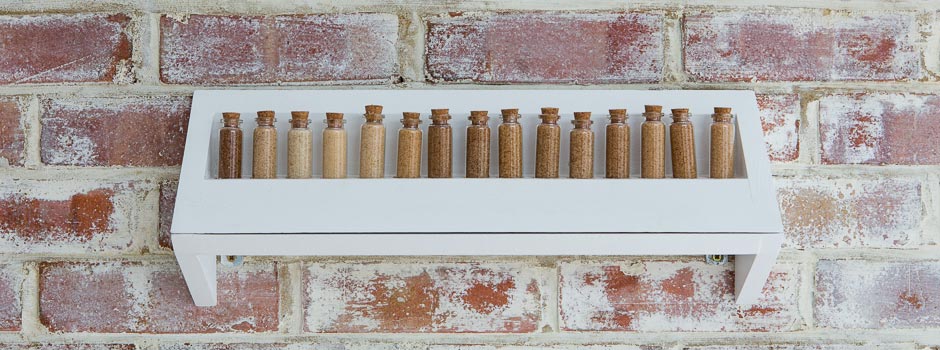
EXHIBITION AT THE THIRD LINE (APRIL 29 – MAY 30, 2015) ‘Sands of Time’ by Zineb Sedira
Apr 08, 2015 Exhibition

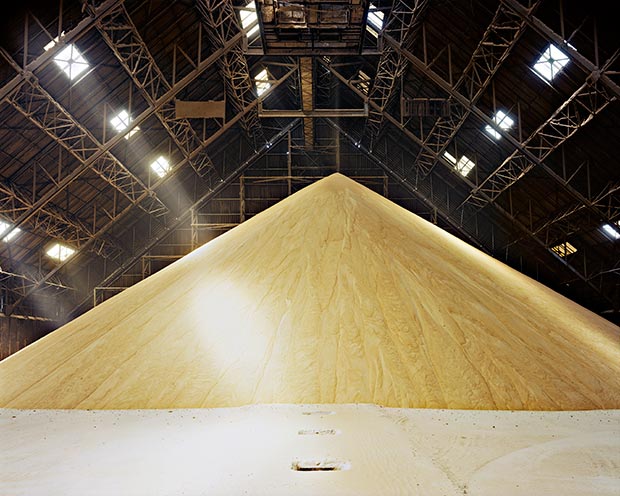 Zineb Sedira, Sugar Silo, Diptych II, 2013, Digital C-types, 160x200 cm each / Courtesy of The Third Line and the Artist
Zineb Sedira, Sugar Silo, Diptych II, 2013, Digital C-types, 160x200 cm each / Courtesy of The Third Line and the Artist
A relatively new body of work, Zineb’s photographs for the Sugar Routes series have all been produced in 2013. The documentation traces the movement of sugar, starting its journey from locations across the world, and ending in the Port of Marseille, to form the sugar silos of St. Louis Sucre. The warehouse storage rooms become backgrounds to a new kind of landscape, where the heaps of different coloured sugar resemble mountains. After filtering, the sugar is packaged off as a global commodity, its own local identity being lost somewhere along the trade routes. However, the sugar leaves behind traces of its presence on the walls that temporarily house it. These are documented by the artist as symbolic commentary on human mobility, presenting concepts of legacy and its transmission, and mankind’s impact on his environs.
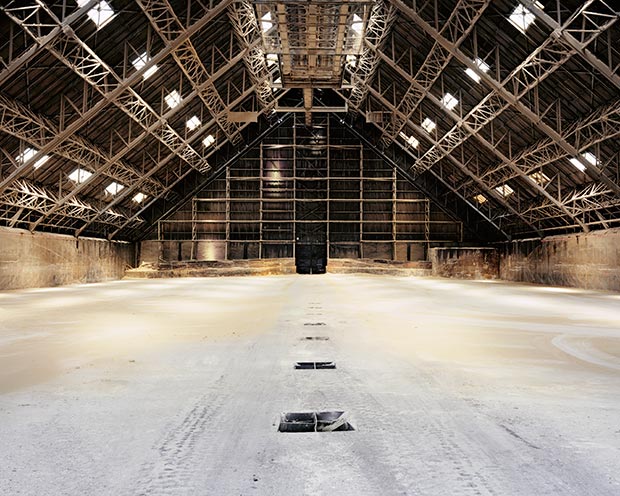 Zineb Sedira, Sugar Silo, Diptych I, 2013, Digital C-types, 160x200 cm each / Courtesy of The Third Line and the Artist
Zineb Sedira, Sugar Silo, Diptych I, 2013, Digital C-types, 160x200 cm each / Courtesy of The Third Line and the Artist
The exhibition also includes two sculptural interventions that tie the relationship between sugar and maritime elements. In sugar covered ship parts (Sugar Routes II), and bottles containing sugar samples from all across the world (Seafaring), the substance becomes more than its commercial, literal self. Instead it becomes a metaphorical reference to individuals, who journey across these same routes; often in search of better lives.
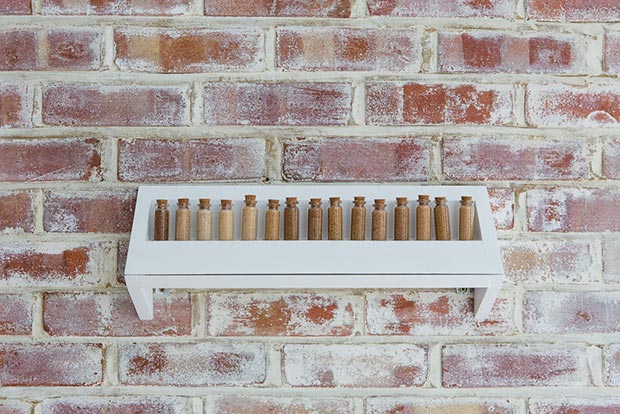 Zineb Sedira, Seafaring, 2013, 15 glass bottles with cane sugar, 50x12.5x12.5 cm / Courtesy of The Third Line and the Artist
Zineb Sedira, Seafaring, 2013, 15 glass bottles with cane sugar, 50x12.5x12.5 cm / Courtesy of The Third Line and the Artist
The video installation in the Project Space, Transmettre en abyme, is a unique documentation of the late Marcel Baudelaire's compulsive photographic ‘ship spotting’ of the vessels that arrived and departed from the port of Marseille from 1935 to 1985. The archive is looked after by Helene Detaille, who is seen in the video passionately explaining the systems of documentation – counting, ordering and classification of Baudelaire’s archive – as well as her methodology in preserving the archive. The collected images speak of the endless flow of goods and human cargo transported by the vessels Baudelaire photographed. Transmettre en abyme adds to Zineb’s practice of preserving historical narratives and her impassioned relationship with the sea.
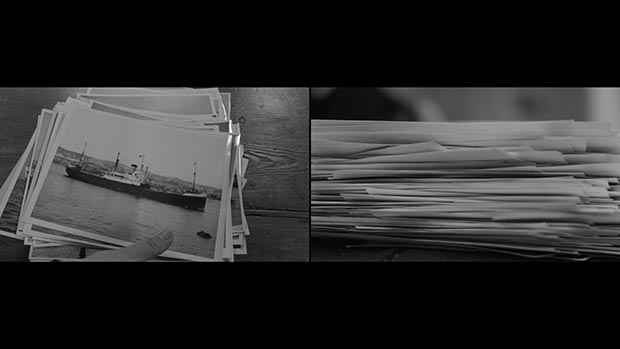 Zineb Sedira, Transmettre en abyme, Three screen video installation, Still 1 / Courtesy of The Third Line and the Artist
Zineb Sedira, Transmettre en abyme, Three screen video installation, Still 1 / Courtesy of The Third Line and the Artist
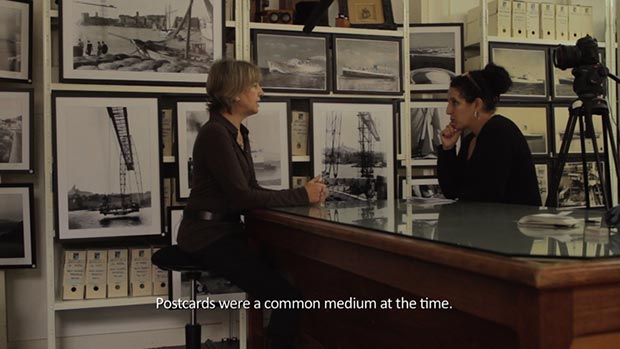 Zineb Sedira, Transmettre en abyme, Three screen video installation, Still 2 / Courtesy of The Third Line and the Artist
Zineb Sedira, Transmettre en abyme, Three screen video installation, Still 2 / Courtesy of The Third Line and the Artist
Zineb Sedira was born in Paris to Algerian parents in 1963. She studied at the Central St Martin’s School of Art and the Slade School of Art, followed by research studies at the Royal College of Art. The artist's photographs and video installation use the perspective of her own experience to frame questions about language, transmission, memory and mobility.
Zineb's work has been included in many solo exhibitions such as at Charles H. Scott Gallery, Vancouver (2013); Galerie Kamel Mennour (2011); Palais de Tokyo, Paris (2010); Rivington Place, London (2009); Pori Art Museum, Finland (2009); Centre Culturel Francais, Algiers (2008); Photographers Gallery, London (2006); Cornerhouse, Manchester (2004); Rencontres de la Photographie d’Arles (2002). Her work has also been included in extensive group exhibitions, including The Divine Comedy: Heaven, Hell, Purgatory revisited by Contemporary African Artists, MMK Museum fur Modern Kunst, Frankfurt, Smithsonian National Museum of African Art, Washington D.C. (2014 - 2015); The Mediterranean Approach, Palazzo Zenobio, 54th Venice Biennale (2011); Told, Untold, Retold, Mathaf - Arab Museum of Modern Art, Doha (2010); Elles@centrepompidou, Centre Pompidou, Paris (2009); Still Life: Art, Ecology and the Politics of Change, Sharjah Biennal 8 (2007); La Video; Un Art, Une Histoire 1965-2005, touring internationally (2006); Africa Remix, Museum Kunst Palast, Dusseldorf, Hayward Gallery, London (2004); Self-Evident: Making the Self the subject of Art from 1970 to the present Day, Tate Britain, London (2002); Authentic/ex-centric Africa In and Out Africa, 49th Venice Biennale (2001). Zineb Sedira won several awards including the Decibel Visual Arts Awrards (2004) and the Prix SAM pour l’art contemporain (2010). In 2015, Zineb was nominated for the Prix Marcel Duchamp.
Zineb's work is in numerous public collections including Centre Pompidou, Musee National d’Art Moderne, Paris; FRAC Provence-Alpes-Cote d’Azur, Marseilles; Gallery of Modern Art, Glasgow Museums, Glasgow; Mathaf – Arab Museum of Modern Art, Doha; Musee d’Art Moderne de la Ville de Paris; Musee national de l’histoire et des cultures de l’immigration/ Cite nationale de l’histoire, Paris; mumok – Museum Moderner Kunst Stiftung Ludwig, Vienna; Sharjah Art Museum, Sharjah; Tate, London; Victoria and Albert Museum, Contemporary Wall Paper Collections, London.
Zineb lives and works between Algiers, Paris and London.
The Third Line is a Dubai-based art gallery that represents contemporary Middle Eastern artists locally, regionally and internationally. The Third Line also hosts non-profit, alternative programs to increase interest and dialogue in the region. Represented artists include: Abbas Akhavan, Ala Ebtekar, Amir H. Fallah, Arwa Abouon, Babak Golkar, Ebtisam Abdulaziz, Farhad Moshiri, Fouad Elkoury, Golnaz Fathi, Hassan Hajjaj, Hayv Kahraman, Huda Lutfi, Joana Hadjithomas & Khalil Joreige, Laleh Khorramian, Lamya Gargash, Monir Shahroudy Farmanfarmaian, Pouran Jinchi, Rana Begum, Sahand Hesamiyan, Sara Naim, Sherin Guirguis, Shirin Aliabadi, Slavs and Tatars, Sophia Al-Maria, Tarek Al-Ghoussein, Youssef Nabil and Zineb Sedira.
Comments
Add a comment